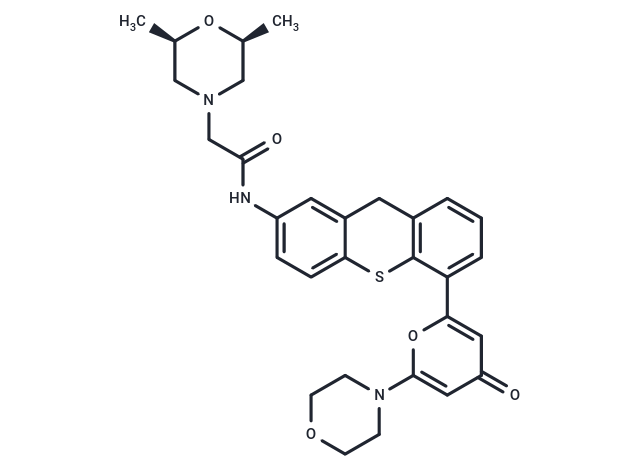Shopping Cart
- Remove All
 Your shopping cart is currently empty
Your shopping cart is currently empty

Ku-60019 is a potent, reversible inhibitor of ATM kinase (IC50: 6.3 nM). It is much less effective or without effect against a panel of 229 other kinases.

| Pack Size | Price | Availability | Quantity |
|---|---|---|---|
| 1 mg | $48 | In Stock | |
| 5 mg | $108 | In Stock | |
| 10 mg | $153 | In Stock | |
| 25 mg | $298 | In Stock | |
| 50 mg | $442 | In Stock | |
| 1 mL x 10 mM (in DMSO) | $142 | In Stock |
| Description | Ku-60019 is a potent, reversible inhibitor of ATM kinase (IC50: 6.3 nM). It is much less effective or without effect against a panel of 229 other kinases. |
| Targets&IC50 | ATM:6.3 nM (cell free) |
| In vitro | KU-60019 is an improved inhibitor of the ATM kinase with an IC50 of 6.3 nM, approximately half that of KU-55933. The IC50 values for DNA-PKcs and ATR are 1.7 and >10 μM, respectively, almost 270-and 1600-fold higher than for ATM [1]. KU-60019 at 300 nM completely inhibited p53 and H2AX phosphorylation as quickly as 15 min after application. When U1242 cells were treated with KU-60019 for 1 h, washed to remove KU-60019 and then challenged with IR, the inhibitory effects of KU-60019 were reversed as early as 15 min after washout [2]. |
| In vivo | Despite PTEN-deficient control tumors reaching a 4-fold increase in size before PTEN wild-type controls, KU-60019–treated PTEN-deficient tumors displayed a statistically significant slowing in growth. This growth inhibition was especially evident at the start of the experiment (days 5–12) just after KU-60019 was administered (days 1–5) [3]. When mice harboring U1242/luc-GFP tumors were treated with KU-60019 administered from an osmotic pump followed by 2 Gy of irradiation, we were able to demonstrate a complete elimination of tumor cells on day 20 by bioluminescence imaging (BLI) 7 days after radiation [4]. |
| Cell Research | Cell growth was determined by AlamarBlue. U1242 cells were serially diluted, allowed to attach for 6 h and then exposed to KU-60019 at 3 μM. At days 1, 3 and 5 after seeding, AlamarBlue was added to the medium to the recommended final concentration. Plates were incubated for 1 h at 37°C and fluorescence determined on a FluoroCount plate reader (excitation 530 nm, emission 590 nm) and values taken as a measure of cell growth [1]. |
| Animal Research | Cells (3 × 10^7) were implanted into male Fox Chase Severe Combined Immunodeficiency (SCID) mice. Administration of doxycycline was started when tumors reached 100 mm3 in volume and was performed every 48 hours up to removal of the animal from the experiment. Forty-eight hours after PTEN induction, animals were administered KU-60019 (100 mg/kg) for 5 consecutive days and measured until they reached a target 400 mm3 volume. Measurements of tumor volume and body weight took place every 3 days using calipers [3]. |
| Alias | KU-60019, KU 60019 |
| Molecular Weight | 547.67 |
| Formula | C30H33N3O5S |
| Cas No. | 925701-49-1 |
| Smiles | C[C@H]1CN(CC(=O)Nc2ccc3Sc4c(Cc3c2)cccc4-c2cc(=O)cc(o2)N2CCOCC2)C[C@@H](C)O1 |
| Relative Density. | 1.314 g/cm3 |
| Storage | Powder: -20°C for 3 years | In solvent: -80°C for 1 year | Shipping with blue ice. | ||||||||||||||||||||||||||||||
| Solubility Information | DMSO: 50 mg/mL (91.3 mM), Sonication is recommended. H2O: < 1 mg/mL (insoluble or slightly soluble) Ethanol: < 1 mg/mL (insoluble or slightly soluble) | ||||||||||||||||||||||||||||||
Solution Preparation Table | |||||||||||||||||||||||||||||||
DMSO
| |||||||||||||||||||||||||||||||

Copyright © 2015-2024 TargetMol Chemicals Inc. All Rights Reserved.